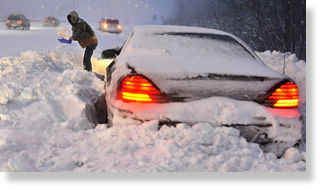
Hundreds of schools remained closed in Massachusetts as crews continued to clear snow and to salt icy roadways, according to state Emergency Management spokesman Peter Judge.
The state's 250 National Guardsmen -- who were mobilized as a precautionary measure on Wednesday -- were relieved from duty by Thursday morning, Judge said.
Delta Air Lines canceled more than 200 Delta and Delta Connection flights in an effort to minimize delays, the airline said. It had canceled 1,300 flights Wednesday because of the storm.
Amtrak, which had suspended rail service between New York City and points north, resumed full service by Thursday morning, according to Amtrak spokesman Cliff Cole.
Officials said snow accumulation in scattered areas across Massachusetts, Connecticut, Rhode Island, New Hampshire and Vermont reached up to 30 inches, while most areas received between 8 and 16 inches of snow.
Snowfall in the heaviest areas reached rates of 2 to 3 inches per hour on Wednesday, according to the National Weather Service.
Some residents in Brattleboro, Vermont, donned cross-country skis as they traveled down snow-jammed roads, while their neighbors heaved shovelfuls of snow out of driveways and sidewalks, said town resident Caleb Clark.
By Thursday, some 1,500 households remained without electricity in Massachusetts, according to the National Grid utility company's website. Tens of thousands of residents had lost power Wednesday evening when high winds and fallen trees knocked out transmission-lines.
The hardest-hit areas included Plymouth, Bristol, Essex, Norfolk and Suffolk counties in Massachusetts, the utility company said.
"This is the second major storm we are battling in less than three weeks," said Christopher E. Root, National Grid senior vice president of electricity operations. "We ask that our customers bear with us and be patient as our crews work in challenging weather conditions to restore service as safely and quickly as possible."
New York Mayor Michael Bloomberg said only 30 vehicles had been towed as a result of the storm.
That number is in stark contrast to the thousands of cars, buses and ambulances left stranded last month after cleanup crews struggled to plow streets days after the storm.
Bloomberg, who faced sharp criticism over the slow emergency response, said New York was better equipped to tackle Wednesday's storm.
More than 1,700 flights were canceled at the New York area's three major airports, while hundreds more were grounded at Boston's Logan International Airport, officials said.
The general manager at LaGuardia Airport, Thomas Bosco, said many airlines pre-emptively canceled flights ahead of the weather to avoid massive delays that plagued airports during last month's holiday blizzard.
The storm swept into the Northeast after dumping unusually heavy snow across the South. Every U.S. state except Florida has snow on the ground, including Hawaii, according to CNN meteorologist Sean Morris.
In Atlanta, Mayor Kasim Reed pledged city streets will be able to handle weekend crowds at several downtown events, including the NFC divisional playoff game Saturday evening at the Georgia Dome.
"The administration, in conjunction with the Georgia Department of Transportation and private contractors, have worked aggressively to clear roads and ensure the safety and welfare of Atlanta residents," his office said in a statement Thursday.
Reed came under criticism for the city's planned response to the snow, which arrived Sunday night.
The city expanded its fleet of snow response equipment from 10 pieces to 58 Tuesday. By Thursday, more than 115 vehicles were clearing the effects of the largest snow event in at least a decade.



Reader Comments
to our Newsletter